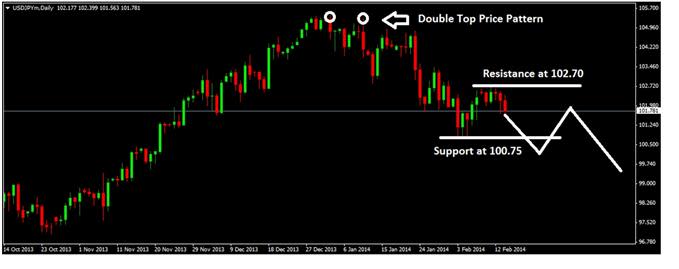Forex - USD/JPY - Impact of Japan’s January Trade Balance
A number of high profile economic reports about Japan’s economy are due this week that might stir volatility in the price of US Dollar and Japanese Yen (USD/JPY).In this article, we are going to discuss the impact of three important economic releases which are scheduled for release on Wednesday, February 19th. The reports include:
• Foreign bond investment in local currency for the week of February 14
• Local currency investment in Japan stocks by foreigners for the week of February 14
• Total merchandise trade balance for the month of January
All three are medium-level economic releases, meaning moderate volatility is expected in the price of Japanese Yen (JPY) following the releases. Let’s take a look at each event one by one.
Foreign Investment in Local Currency Bonds
This is a securities investment report, released by Japan’s Ministry of Finance every week. The report shows the value of bonds issued by foreigners in a domestic market in local currency, i.e. the Japanese Yen (JPY). The report details the flows from the public sector excluding the Bank of Japan (BoJ). The data reveals the net flows, i.e. the difference of total capital inflows and total capital outflows.
Net Flows = Incoming Capital - Outgoing Capital
A positive outcome shows net sales of foreign bonds (capital inflow). A negative outcome shows net purchases of foreign bonds (capital outflow).
Generally speaking, net purchases of foreign bonds tend to weaken the Japanese Yen (JPY) and net selling of foreign bonds strengthens the Japanese Yen (JPY).
Local Currency Investment by Foreigners in Japan Stocks
This is also a weekly report issued by Japan’s Ministry of Finance. The report shows the total value of local currency investment, by foreign entities, in Japanese stocks during a specific week. Generally speaking, a high reading is seen as bullish (positive) for the Japanese Yen (JPY) and a low reading is seen as bearish (negative) for the Japanese Yen (JPY).
Total Merchandise Trade Balance
This is a monthly report released by Japan’s Ministry of Finance. The report shows the difference between total exports and total imports during a specific month.
Net Income = Total Exports – Total Imports
A positive figure shows trade surplus while a negative outcome signals trade deficit.
Generally speaking, trade surplus is seen as bullish (positive) for the Japanese Yen (JPY) and trade deficit is seen as bearish (negative) for the Japanese Yen (JPY).
How to Trade these Reports?
US Dollar and Japanese Yen (USD/JPY) is approaching a strong support near 100.75. If the price breaks below 100.75, it will indicate a bearish trend. Conversely, if the pair holds off this support level, then the trend will be bullish.
Now we come to the reports. The merchandise trade balance figure for January will be the most important among the three above mentioned releases. In December, the trade balance report showed a 1.302.1 billion JPY deficit. According to a median projection of analysts, the deficit rose to 2,489 billion JPY in January. So if the actual reading, for January trade balance, comes out to be worse than expectations, it will be positive for the US Dollar and Japanese Yen (USD/JPY) pair and vice versa. Depending upon the outcome of the reports, buying from 100.00 – 100.75 and selling from 102.70 – 103.50 can be good options.
DailyFX provides forex news and technical analysis on the trends that influence the global currency markets.
Learn forex trading with a free practice account and trading charts from FXCM.

 Yahoo Finance
Yahoo Finance 

